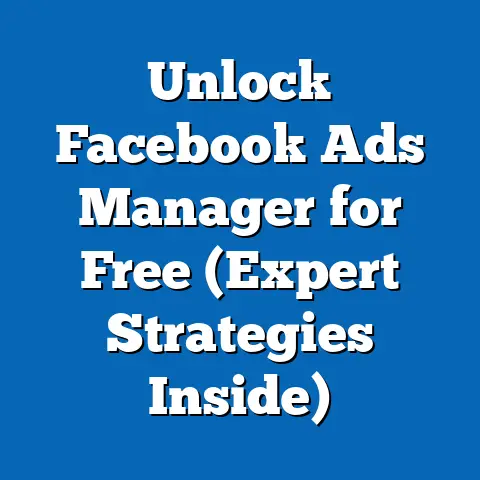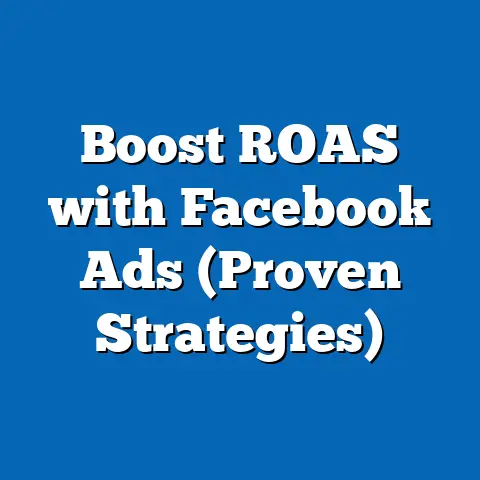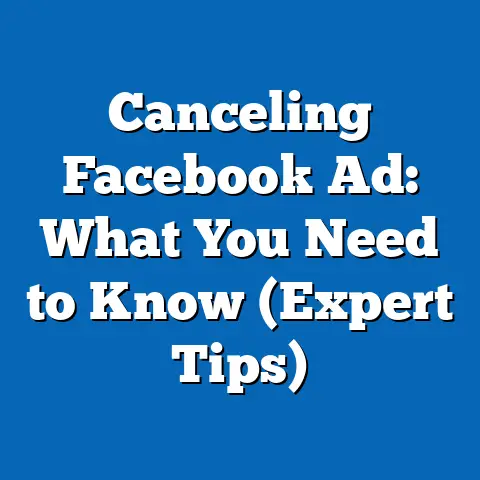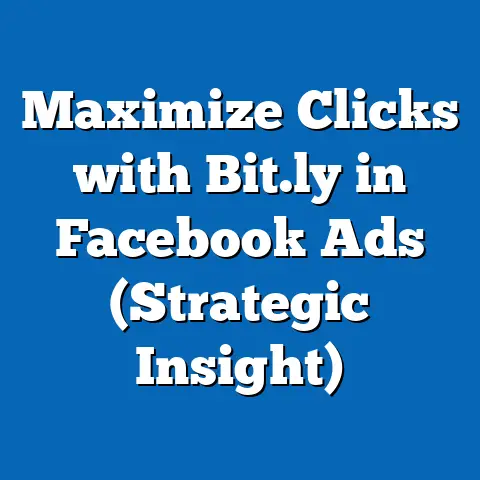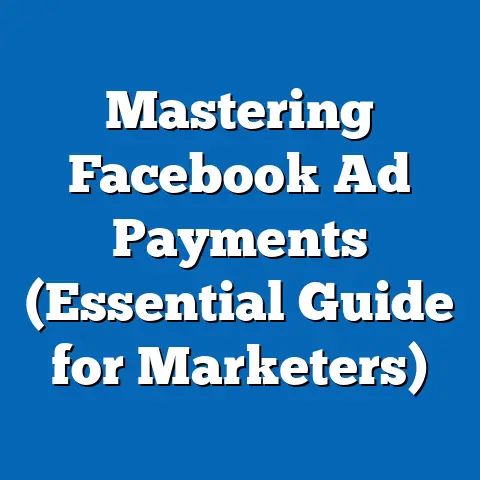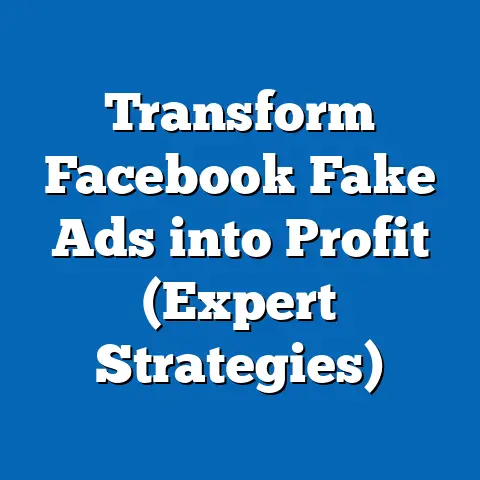Optimize Facebook Ad Campaign Structure (Expert Strategies)
I remember the first time I dove into Facebook advertising. It was 2013, and I had this shiny new product I was sure everyone needed. I threw up an ad, targeted “people who like things,” and waited for the money to roll in. What I got instead was a trickle of clicks and a whole lot of confusion. My budget vanished faster than free pizza at a tech conference, and I had absolutely no idea why. It was a classic case of “spray and pray” marketing, and it failed miserably.
That experience, while painful, was a pivotal moment. It sparked a passion for understanding the intricacies of Facebook Ads Manager and figuring out how to structure campaigns for actual results. I spent countless hours reading, testing, and analyzing data, determined to master this powerful platform. Now, I’m here to share what I’ve learned and help you avoid the mistakes I made early on. Let’s get started!
Section 1: Understanding the Basics of Facebook Ads
Facebook Ads are essentially paid messages that businesses use to reach a specific audience on Facebook and Instagram. They’re a cornerstone of modern digital marketing because they offer unparalleled targeting capabilities. You can reach people based on demographics, interests, behaviors, and even custom lists.
Different Types of Facebook Ads and Their Purposes
Facebook offers a variety of ad formats, each designed for different objectives:
- Image Ads: Single image with text. Great for simple messages and product showcases.
- Video Ads: Engaging and can tell a story. Perfect for brand awareness and product demos.
- Carousel Ads: Display multiple images or videos in a scrollable format. Ideal for showcasing multiple products or features.
- Collection Ads: Visually immersive ads that allow people to browse products in a visual format.
- Lead Ads: Collect leads directly within Facebook, making it easy for people to sign up for newsletters or request more information.
- Instant Experience Ads: Full-screen, mobile-optimized experiences that load instantly when someone clicks your ad.
The type of ad you choose depends on your campaign goals. If you’re launching a new product, a video ad might be best. If you’re trying to generate leads, a lead ad is the way to go.
Navigating the Facebook Ads Manager Interface
The Facebook Ads Manager is your central hub for creating, managing, and analyzing your campaigns. Here are some key components to familiarize yourself with:
- Campaigns: The highest level of organization, where you define your overall objective (e.g., traffic, conversions, brand awareness).
- Ad Sets: Where you define your target audience, budget, schedule, and placement (where your ads will appear).
- Ads: The actual creative content (images, videos, text) that your audience will see.
Navigating this interface can feel overwhelming at first, but with practice, it becomes second nature. Think of it as your digital advertising control panel.
Takeaway: Facebook Ads are a powerful tool, but understanding the different ad types and the Ads Manager interface is crucial for success. Spend some time exploring the platform before launching your first campaign.
Section 2: The Importance of Campaign Structure
Why does campaign structure even matter? Let me tell you, it’s the foundation upon which your entire advertising strategy is built. Without a solid structure, you’re essentially throwing money into the wind.
Why a Well-Structured Campaign is Critical
A well-structured campaign allows you to:
- Target the right audience: Segmentation ensures your message resonates with specific groups.
- Optimize your budget: Properly allocating funds to high-performing ad sets maximizes your ROI.
- Track performance effectively: Clear organization makes it easier to identify what’s working and what’s not.
- Scale your campaigns: A structured approach allows you to scale efficiently without losing control.
The Consequences of a Poorly Structured Campaign
On the flip side, a poor structure can lead to:
- Wasted budget: Showing ads to the wrong people results in low engagement and wasted ad spend.
- Poor performance: Ineffective targeting leads to low conversion rates and a poor return on investment.
- Difficult analysis: Disorganized campaigns make it hard to identify areas for improvement.
- Missed opportunities: Failing to target the right audiences means missing out on potential customers.
Understanding the Marketing Funnel and Campaign Structuring
The marketing funnel (Awareness, Consideration, Conversion) is a classic model that describes the customer journey. Structuring your campaigns around this funnel is a smart strategy.
- Awareness: Target a broad audience with engaging content to introduce your brand.
- Consideration: Focus on educating your audience about your product or service and building trust.
- Conversion: Target people who are ready to buy with offers and incentives.
For example, let’s say you’re selling a new fitness app. You could create:
- Awareness Campaign: Video ad showcasing the benefits of fitness. Targeted at people interested in health and wellness.
- Consideration Campaign: Blog post ad comparing your app to competitors. Targeted at people who have interacted with your awareness campaign.
- Conversion Campaign: Discount code ad. Targeted at people who have visited your website or downloaded a free trial.
Takeaway: A well-structured campaign is essential for achieving your advertising goals. It allows you to target the right audience, optimize your budget, and track performance effectively. Think of the marketing funnel as your blueprint.
Section 3: Key Components of an Effective Campaign Structure
Let’s break down the key components of an effective Facebook ad campaign structure: campaign level, ad set level, and ad level.
Campaign Level: Objectives and Goals
The campaign level is where you define your overall objective. What do you want to achieve with your advertising? Common objectives include:
- Brand Awareness: Reach a broad audience and increase recognition of your brand.
- Reach: Show your ad to as many people as possible within your target audience.
- Traffic: Drive traffic to your website or landing page.
- Engagement: Encourage likes, shares, and comments on your posts.
- Lead Generation: Collect leads directly within Facebook.
- Conversions: Drive specific actions on your website, such as purchases or sign-ups.
Your objective should align with your overall business goals. If you’re launching a new product, brand awareness might be your primary focus. If you’re trying to increase sales, conversions are the way to go.
Example: Let’s say you’re running an e-commerce store. If your goal is to increase sales, you’d select the “Conversions” objective. If your goal is to get more people to sign up for your email list, you’d select the “Lead Generation” objective.
Ad Set Level: Targeting and Budgeting
The ad set level is where you define your target audience, budget, schedule, and placement.
Audience Targeting and Segmentation: This is where the magic happens. Facebook offers incredibly granular targeting options. You can target people based on:
- Demographics: Age, gender, location, education, job title.
- Interests: Hobbies, passions, pages they like.
- Behaviors: Purchase history, online activity, device usage.
- Custom Audiences: Lists of your existing customers or website visitors.
- Lookalike Audiences: People who share similar characteristics with your best customers.
Budgeting and Bidding Strategies: How much are you willing to spend to reach your target audience? Facebook offers several bidding strategies:
- Lowest Cost: Facebook will try to get you the most results for your budget.
- Cost Per Result Goal: You set a target cost per result, and Facebook will try to achieve it.
- Manual Bidding: You set your own bids for each ad set.
A/B Testing Ad Sets: A/B testing involves creating multiple ad sets with slight variations (e.g., different targeting options, different bidding strategies) to see which performs best. This is a crucial step in optimizing your campaigns.
Example: You could create two ad sets targeting different age groups (25-34 vs. 35-44) with the same ad creative to see which age group is more responsive.
Ad Level: Creative and Messaging
The ad level is where you define the actual creative content that your audience will see.
Compelling Ad Copy and Visuals: Your ad copy should be clear, concise, and persuasive. Your visuals should be high-quality and eye-catching.
Crafting Engaging Headlines and CTAs: Your headline is the first thing people will see, so make it count. Use strong verbs and create a sense of urgency. Your call-to-action (CTA) should tell people exactly what you want them to do (e.g., “Shop Now,” “Learn More,” “Sign Up”).
Aligning Ad Creatives with Audience Preferences: Your ad creative should resonate with your target audience. Use images and language that appeal to their interests and values.
Example: If you’re targeting millennials, use trendy visuals and language. If you’re targeting baby boomers, use more traditional imagery and messaging.
Takeaway: The campaign, ad set, and ad levels work together to create a cohesive advertising strategy. Define clear objectives, target your audience effectively, and create compelling ad creatives that resonate with their preferences.
Section 4: Advanced Structuring Techniques
Ready to take your Facebook advertising to the next level? Let’s dive into some advanced structuring techniques.
Utilizing Custom Audiences and Lookalike Audiences
Custom Audiences: These are audiences you create based on your existing data. You can upload lists of customer emails, phone numbers, or website visitors.
Lookalike Audiences: These are audiences that Facebook creates based on the characteristics of your custom audiences. They’re a powerful way to expand your reach and find new customers who are likely to be interested in your products or services.
Example: Create a custom audience of your best customers and then create a lookalike audience based on that custom audience. This will allow you to target people who share similar characteristics with your best customers.
Dynamic Ads and Catalog Sales
Dynamic Ads: These are ads that automatically show the most relevant products to each individual based on their browsing history and purchase behavior.
Product Catalog: A product catalog is a file that contains information about all of your products, such as images, descriptions, and prices. You can upload your product catalog to Facebook and use it to create dynamic ads.
Example: If someone visits your website and views a specific product, dynamic ads can show them that product again on Facebook. This is a powerful way to retarget potential customers and drive sales.
Utilizing Facebook Pixel for Enhanced Tracking
Facebook Pixel: A small piece of code that you install on your website. It allows you to track conversions, optimize your ads, and build custom audiences.
Using Pixel Data to Optimize Ad Delivery and Retargeting: The Facebook Pixel collects data about your website visitors, such as the pages they visit, the products they view, and the actions they take. This data can be used to optimize your ad delivery and retarget potential customers.
Example: If someone adds a product to their cart but doesn’t complete the purchase, you can use the Facebook Pixel to retarget them with an ad reminding them to complete their order.
Takeaway: Custom audiences, lookalike audiences, dynamic ads, and the Facebook Pixel are powerful tools that can help you optimize your campaigns and drive better results. Experiment with these techniques to see what works best for your business.
Section 5: Monitoring and Analyzing Campaign Performance
You’ve launched your campaign, now what? Monitoring and analyzing your campaign performance is crucial for identifying areas for improvement and maximizing your ROI.
Key Metrics to Monitor
Here are some key metrics to monitor in Facebook Ads Manager:
- Click-Through Rate (CTR): The percentage of people who click on your ad after seeing it.
- Cost Per Click (CPC): The average cost you pay for each click on your ad.
- Cost Per Acquisition (CPA): The average cost you pay for each conversion (e.g., purchase, sign-up).
- Return on Ad Spend (ROAS): The amount of revenue you generate for every dollar you spend on advertising.
Interpreting Data from Facebook Ads Manager
Understanding what these metrics mean is essential for making informed decisions about your campaigns.
- High CTR: Indicates that your ad creative is resonating with your target audience.
- Low CPC: Indicates that your targeting is effective and your bids are competitive.
- Low CPA: Indicates that your ads are driving conversions at a reasonable cost.
- High ROAS: Indicates that your campaigns are generating a strong return on investment.
Ongoing Optimization Based on Performance Metrics
Use the data you collect to make ongoing optimizations to your campaigns.
- Pause or adjust underperforming ads: Don’t be afraid to cut your losses on ads that aren’t working.
- Refine your targeting: Experiment with different targeting options to find the most responsive audiences.
- Test different ad creatives: Try different images, videos, and ad copy to see what resonates best with your audience.
- Adjust your bidding strategy: Experiment with different bidding strategies to optimize your cost per result.
Takeaway: Monitoring and analyzing your campaign performance is an ongoing process. Use the data you collect to make informed decisions about your campaigns and optimize for better results.
Section 6: Case Studies of Successful Campaign Structures
Let’s look at a couple of real-world examples of brands that have successfully optimized their Facebook ad campaign structures.
Case Study 1: E-Commerce Brand (Apparel)
- Challenge: Low conversion rates and high CPA.
- Strategy: Implemented a full-funnel strategy.
- Awareness: Video ads showcasing their brand story, targeted at a broad audience.
- Consideration: Carousel ads highlighting specific product categories, targeted at people who watched the video ads.
- Conversion: Dynamic ads retargeting people who viewed products on their website.
- Results: Increased conversion rates by 50% and reduced CPA by 30%.
Case Study 2: SaaS Company (Software as a Service)
- Challenge: Difficulty generating leads and acquiring new customers.
- Strategy: Leveraged lead ads and lookalike audiences.
- Lead Ads: Offered a free e-book in exchange for contact information, targeted at people interested in their industry.
- Lookalike Audiences: Created lookalike audiences based on their existing customer base.
- Conversion Ads: Targeted the lookalike audiences with ads promoting their software.
- Results: Increased lead generation by 40% and reduced customer acquisition cost by 25%.
Takeaway: These case studies demonstrate the power of a well-structured campaign. By implementing a full-funnel strategy, leveraging custom audiences and lookalike audiences, and optimizing their ad creatives, these brands were able to achieve significant results.
Section 7: Common Mistakes to Avoid
Let’s talk about some common pitfalls to avoid when structuring your Facebook ad campaigns.
- Vague Objectives: Not clearly defining your campaign objectives can lead to unfocused and ineffective campaigns.
- Poor Audience Targeting: Targeting too broad of an audience or using irrelevant targeting options can result in wasted ad spend.
- Ignoring Ad Relevance Score: This score measures how relevant your ad is to your target audience. A low relevance score can indicate that your ad creative or targeting is off.
- Neglecting A/B Testing: Failing to A/B test different ad creatives, targeting options, or bidding strategies can prevent you from optimizing your campaigns.
- Ignoring Mobile Optimization: Many Facebook users access the platform on mobile devices, so it’s crucial to optimize your ads for mobile viewing.
Takeaway: Avoiding these common mistakes can significantly improve your campaign performance. Pay attention to your objectives, target your audience effectively, optimize your ad creatives, and don’t be afraid to experiment.
Conclusion: The Path to Mastery
Mastering Facebook advertising is a journey, not a destination. It requires a combination of structured planning, continuous learning, and a willingness to experiment.
Remember the key takeaways from this article:
- Campaign structure is crucial for success.
- Define clear objectives and align your campaigns with the marketing funnel.
- Target your audience effectively and leverage custom audiences and lookalike audiences.
- Create compelling ad creatives that resonate with your target audience.
- Monitor and analyze your campaign performance and make ongoing optimizations.
- Avoid common mistakes and learn from your experiences.
By applying these strategies to your own campaigns, you can unlock the full potential of Facebook advertising and achieve your marketing objectives. And remember that first campaign I ran? Let’s just say, I’ve come a long way since then. Now it’s your turn. Go out there, experiment, and build some awesome campaigns!

